Estimated reading time: 13 minutes
Our family has been growing apples for a long time. Going back to Katie’s grandparents, we’ve planted literally thousands of apple trees over several generations.
Every tree we’ve planted has been grown and grafted by us.
Learning to grow apples
We’ve pruned hundreds of trees every year. Learned how to manage the many pests and diseases that plague them, without using any toxic chemicals.
We’ve picked, packed, stored, and sold dozens of apple varieties, and learned their different characteristics.
You could say we know apples.
So when we recommend apples as one of the best fruit trees to grow at home, we’re speaking from experience.
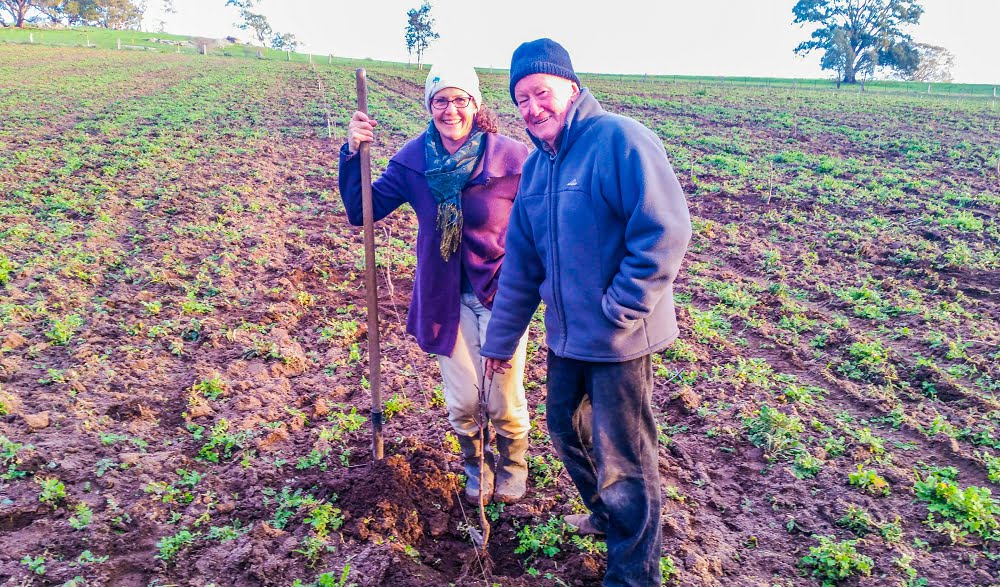
Why do apples make such great backyard trees?
Apples are one of the oldest domesticated fruit types. They have a history that goes back at least 10,000 years to their origins in Kazakhstan. As they became domesticated they spread first to Europe, and then across the whole world.
They’ve been one of the most-loved fruit trees for a very long time, and for good reason:
- The trees and the fruit are quite robust, making them easy to grow, and a reliable cropper.
- There’s a huge range of varieties available that ripen at different times. This makes it possible to plan for a very long harvest.
- They grow well in a wide range of climates, especially with the new low-chill varieties.
- The fruit is versatile. It is delicious, very healthy, stores well, and is easily preserved in many different ways, including bottling, drying, sauce, chutney, juice, vinegar, and cider.
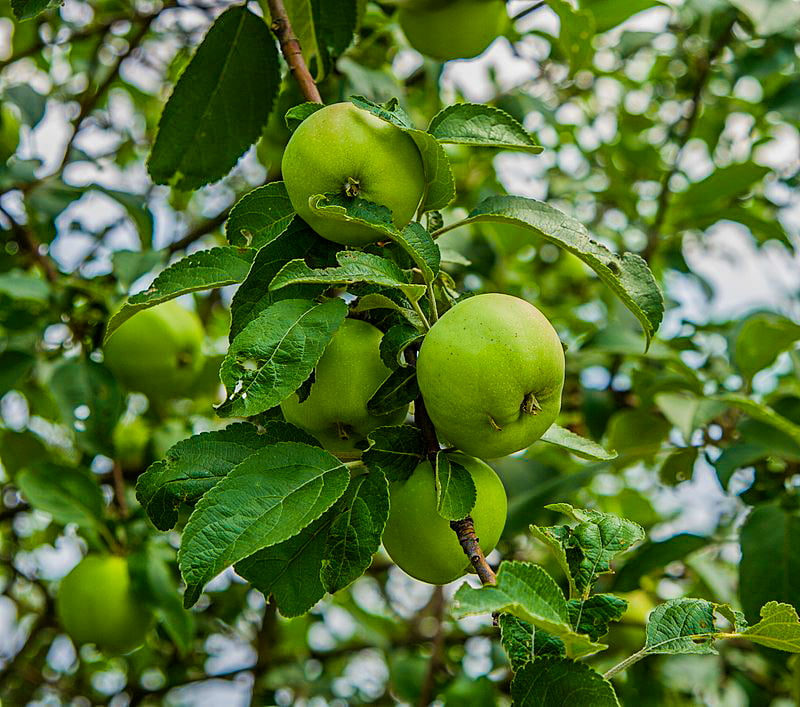
What conditions do apples need to grow well?
Apples prefer to grow in full sun, though in very hot climates the fruit may need some protection against sunburn.
They also need cool winters so they can accumulate enough “chill factor”. Chill factor is a buildup of the number of hours at a low temperature. It’s required for the buds to break dormancy in spring. Most varieties need between 400-1800 hours.
Apple trees prefer well-drained soil that is high in organic matter. If you’re planning to grow your apples organically (which we highly recommend), then steer clear of synthetic fertilisers. They are usually quite salty and can damage the natural fertility system that apple trees evolved with over thousands of years.
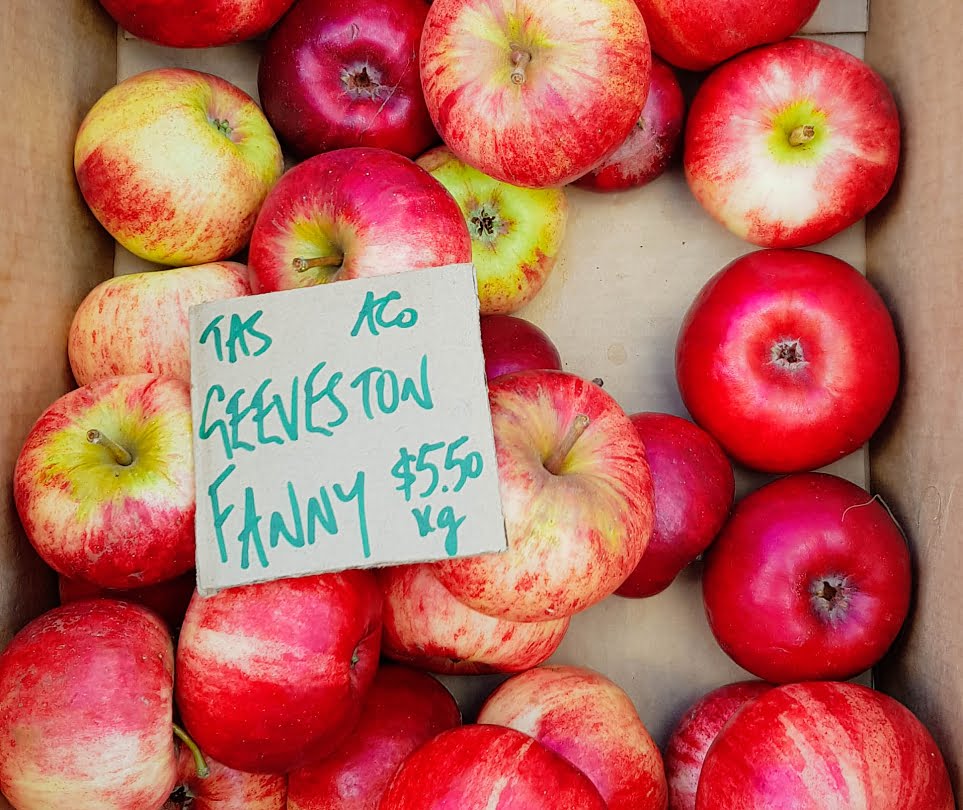
Looking after the soil is key
Feed the soil under your apple trees with compost, worm castings, compost tea, or aged manure. These are all natural products that help to build soil health over the long term. Growing a mix of plants such as flowers and herbs under your apple trees will also help to build up soil health.
If they’re growing in healthy soil, apples will produce healthy, nutrient-dense fruit year after year.
The one thing apple trees don’t like is frost, particularly in spring when the trees are flowering. Being aware of this and choosing a site for your apple tree that is relatively frost-free will definitely pay off for you in the long run.
However, don’t be put off having an apple tree just because you get frosts. It’s relatively easy to protect your tree against frosts with site choice, microclimates, and frost covers.
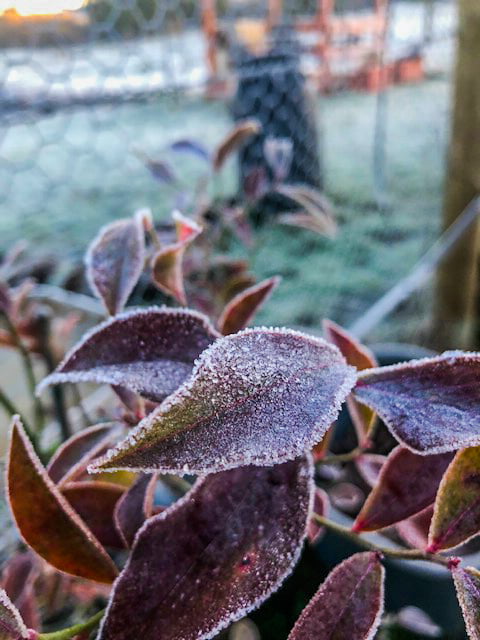
How do you choose which apple varieties to grow?
How many different apples can you name?
You probably know Pink Ladies, Fuji, and maybe Gala or Granny Smith. For many, that’s as far as it goes—after that, it’s “red apples” or “green apples”. If you can name 10 you’re doing really well.
That’s largely because the number of types of fruit grown by big growers (and therefore sold in supermarkets) has shrunk over the last few generations. And while there’s lots of research being done into new varieties, most will not end up in large-scale production, and it’s likely you’ll never hear of them.
So it might surprise you to know that there are literally thousands of named apple varieties (or cultivars) known. Most of them are not usually found in nurseries these days, but you can find a wide range if you go hunting for them.
Why has the number of types of apples shrunk?
As with every other area of agriculture, it’s a response to the commercialisation and globalisation of our food systems. For a type to stay on a grocery shelf (and therefore on a modern farm) it must:
- be more productive
- stand many months of cold storage with no loss of quality
- have a long shelf life
- be able to travel well, and
- be very consistent in looks.
And as farms get bigger and bigger, it’s just a lot more practical and cost-effective to grow 100 (or 1,000) hectares of the same variety. Sadly, that means that the number of varieties you can buy is very small, and many of the older cultivars are out of production.

Why you should grow as many types of apples as you can
As a backyard grower, you have the luxury of being able to create a polyculture. Polycultures include as many different varieties of fruit as possible, as well as other plants.
Amongst the thousands of different apple varieties, some have the most fabulous names (who could resist growing Geeveston Fanny or Peasgood Nonesuch?) But they also have many different characteristics.
This diversity is one of the magical things about growing apple trees.
There are apples that are better suited to eating fresh, storing, drying, juicing, or making cider. It’s easy to find apples that appeal to a wide variety of palates, from very sweet to quite sour, or even bitter. Choosing varieties that ripen early or late also allows you to stretch your harvest period over many months.
We have a heritage apple project underway on our farm where we’re building a collection. We’re including many varieties you’ve probably never heard of (and must admit we chose some just for the name).
So, why are we swimming against the tide and suggesting that you plant exactly the opposite of a monoculture?
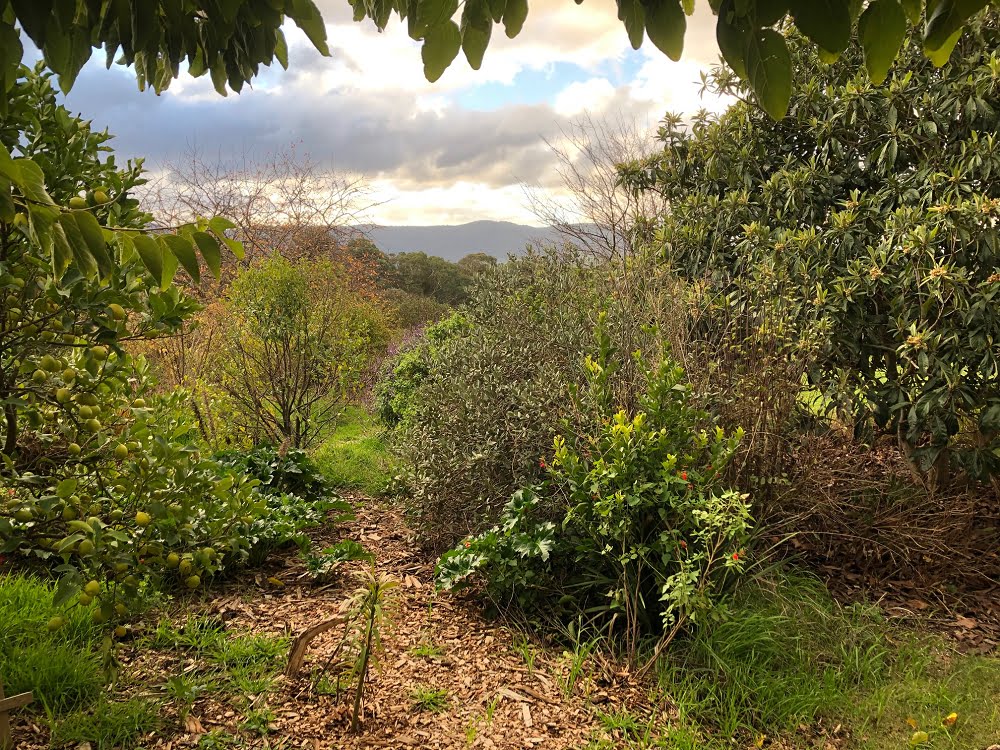
Protecting against risk with diversity
A diverse garden is much healthier than a monoculture for many reasons. An important one is that it helps to keep pest populations under control.
It also provides the best protection against risk that we know of. If the wild weather conditions (drought, flood, hail…) we’ve experienced on our farm have taught us anything, it’s that diversity is our best chance of bringing home a crop every single year, regardless of the weather conditions.
The variability between different varieties in things such as the timing of flowering, harvest times, and resistance to diseases all increase the chance that when an adverse event happens it won’t affect all your trees to the same degree.
That means that the more varieties you have, the better chance that at least some of your varieties will safely reach maturity each year.
Which apple varieties should you choose?
The answer depends on how much space you have, and your goals for your fruit trees.
If you have room, try to choose at least one variety that ripens early in the season, one mid-season, and a late-ripening cultivar.
The actual varieties you choose will depend on what you want to do with the fruit. Different varieties suit eating, drying, preserving, juicing, or making cider. More than 80 varieties are listed within the Fruit Tree Database we provide for Grow Great Fruit members.
Which apple rootstock will suit you best?
You’ve probably heard of dwarfing rootstocks?
Many different types of dwarfing rootstock are available. One of the largest is the MM111, which grows to about 80% the size of a seedling tree. One of the smallest is the M26, which is only about 40% of the size of a seedling tree.
Many of the trees you can buy at nurseries are labelled as ‘dwarf’ trees, but this is another area where we tend to buck the trend.
Here on the farm, we grow our trees on seedling rootstock, which are trees grown straight from an apple seed.

Seedlings were the original apple rootstock
Seedlings grow into trees that are the biggest possible size an apple tree can become. In fact, seedlings are what sets the benchmark standard of 100% that other rootstocks are measured against.
Seedling trees can get huge (up to 5m tall). This means they are harder to prune, harder to thin, and harder to pick than dwarf trees. Pretty much everything has to be done up a ladder. However, with diligent pruning and careful management, you can stop the trees from becoming too huge.
We like seedling rootstocks because during the last drought, we observed that trees on dwarfing rootstocks really struggled. However apple trees on seedling rootstock—even the ones that had no irrigation—survived the drought. They are one tough tree, which makes them the perfect tree for droughts.
However, seedling trees are also harder to manage and take up more space. If either of these things is an issue for you, it’s probably safer to choose one of the smaller rootstocks.
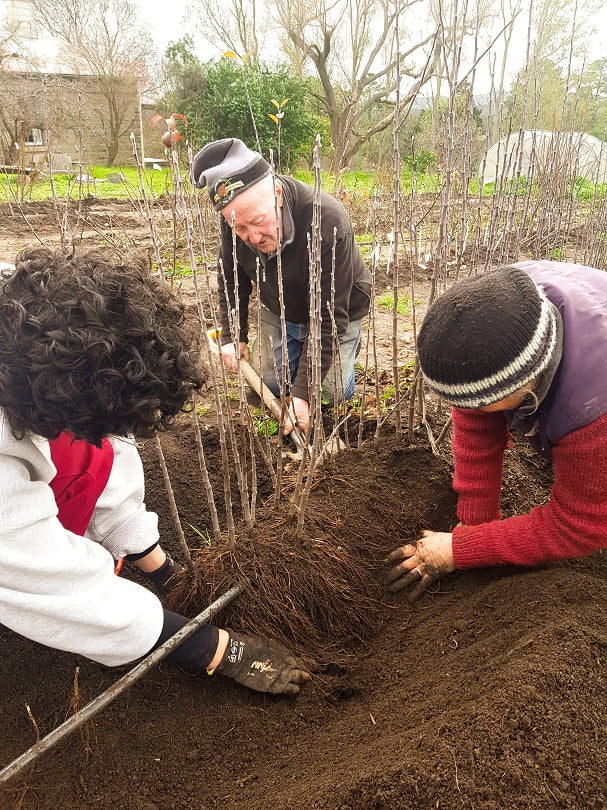
Looking after your apple tree
Managing weeds
As we’ve already mentioned, your trees will be healthier if you grow a wide range of other plants beneath them. This might include herbs, flowers, or vegetables.
Even a lot of plants you normally think of as weeds can be very beneficial to the soil. Therefore most “weed management” is not about killing or removing weeds. It’s more about planting and looking after the understorey.
However, it’s a good idea to reduce competition from weeds for the first couple of years. Mulch the trees when you plant them, then replace the mulch with living plants as the tree gets established.
Thinning
Fruit thinning is the practice of removing some of the fruit from the tree just after flowering. It’s particularly important to do this with apples. Most varieties will otherwise fall into the habit of biennial bearing, or only having a crop every second year.
Pruning
Apple trees can be pruned into a wide variety of different forms. The one we recommend that suits most backyards is the vase shape.
Apples are also well suited to many variations of espalier, though some rootstocks suit this form better than others. A mid-range dwarfing rootstock will suit most espalier systems.
Pests and diseases
Apple trees have a range of pests and diseases that can attack them. The most commonly known (and most likely to bother you) include:
- Codling moth
- Apple dimpling bug
- Black spot
- Bitter rot
- Bitter pit
- Fruit fly
Learning how to manage pests and diseases without chemicals was one of the biggest hurdles to jump when we changed to organic production.
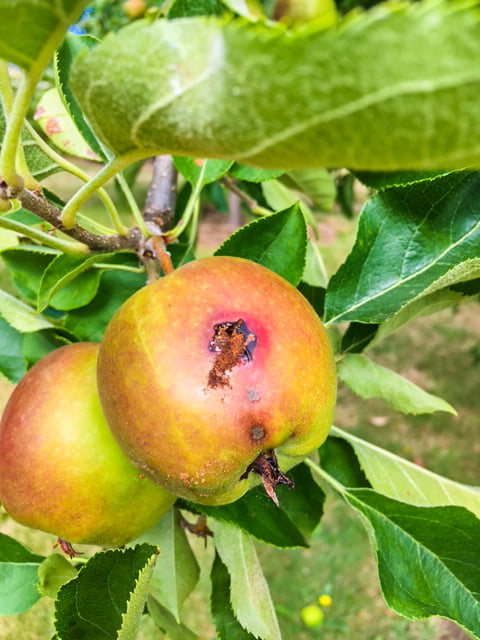
We made soooooo many mistakes over the years.
But over time, we learned how to manage all of them. It turned out that even the problems that seemed unbeatable (like codling moth and fruit fly) have multiple solutions.
Through trial and error, we’ve developed a ‘toolbox’ of organic solutions for each of these pests and diseases.
Irrigation
Apple trees do well in dry climates, but they do need regular watering.
The most efficient way to do this is to set up a simple (and preferably automatic) irrigation system. One dripper per tree is usually enough. Adult trees usually need watering a couple of times a week. Young trees or trees with no crop can often be watered once a week.
Why you should include an apple tree in your garden
Apple trees require a bit of specialist knowledge, particularly when it comes to pruning, and preventing pests like codling moth and fruit fly. But they’re totally worth the effort.
In many ways, they’re less vulnerable and a bit tougher than stone fruit. And because they store so well, they’re a key player in providing year-round fruit from your garden if that’s your aim.
You can also become part of the global movement to preserve and maintain heritage varieties by including one (or more) in your garden.
It’s great to have antique varieties in collections, but it’s much better to have them in ordinary gardens.
That way the apples will be eaten, appreciated, and shared – and the more people that get to know and love a variety, the better chance it has of surviving into the future.
Related Articles
Expert tips on growing organic berries
Berries are one of the easiest and most successful fruits to add to your garden if you’re looking for quick results.
How to make and use a fruit picking diary
Using a fruit-picking diary can help solve the problem of choosing the exact time to pick your fruit so it’s neither under-ripe nor over-ripe.
How to make the simplest fruit dessert in the world
Summer calls for fruit desserts, and this is one of our simple “go to” recipes. We don’t have time to fuss, but we still love our food!

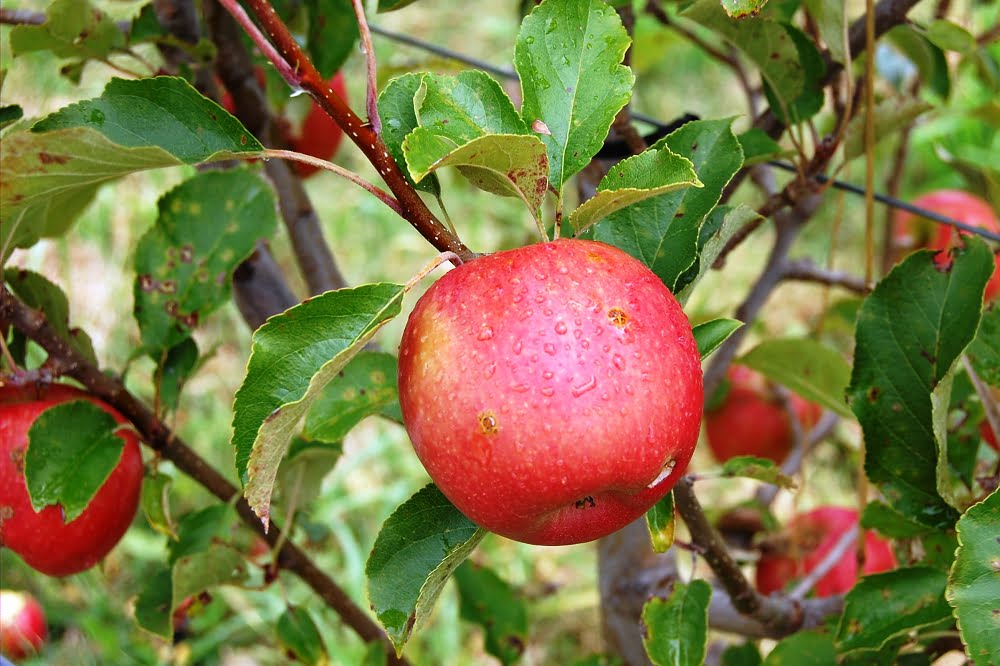

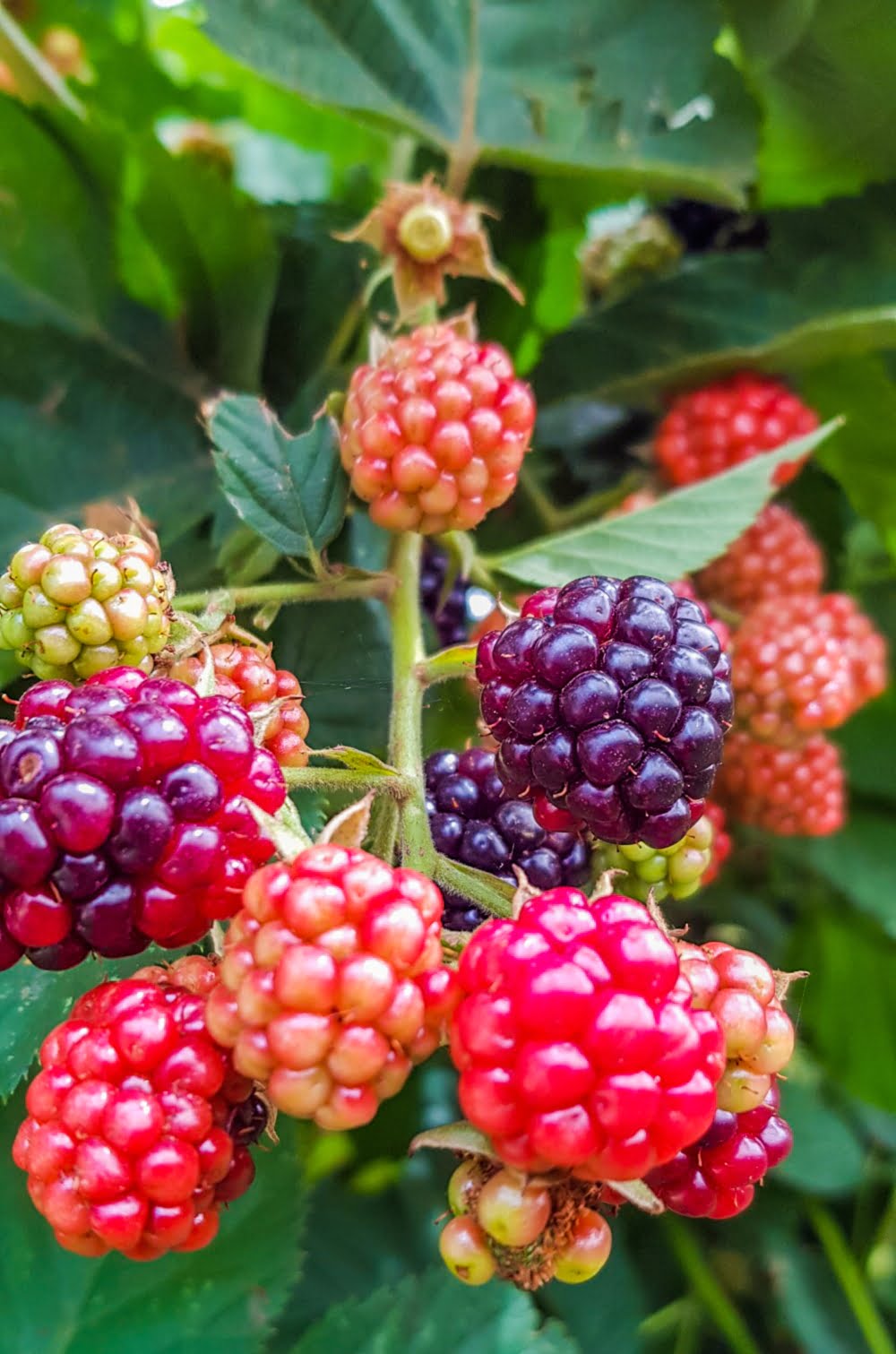
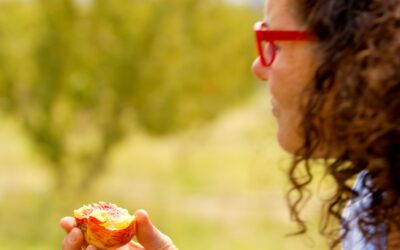



I’ve grown some seedlings – from seeds – only a year old
From – Royal Gala, Granny Smith, Golden Delicious
I’ve heard they won’t grow those apples – do you graft from existing trees to seedlings to get the apples you want? When do you do this? How old are the seedlings when you do this?
I’m OK with getting different apples but I wonder if any heirloom variety of apples from a seedling that grow true to name?
Would love your thoughts on this 🙂
TAS location
Hi ASM, great questions! All apples are pollinised by a different variety, which means the seeds they produce are a genetic mix of the two parents. That’s why they’ll never come true to type. The only exception may be if a variety was self-fertile (but we don’t know of any). Also, you’d still have to be sure that an individual apple HAD been fertilised by another flower on the same tree, and there’s no way you can know this.
So, yes, you definitely need to graft those seedlings you’ve grown, using wood from existing trees. The easiest time to do this is in February, using the grafting technique called budding. If the seedings aren’t big enough to do this (they need to be about pencil thickness) then wait until next spring and use a different grafting technique called “whip-tongue”. We’ve got short courses on both of those techniques (with videos). Happy grafting!
fabulous article, thank you so much!
I’m a first time grower of apples and my granny smith (five years old) has sunburn, so next year I’ll organise some protection.
We have espaliered our granny smith and my husband and I decided we will have one side each, so we did a pre summer prune. His side is groaning with apples and my side has a few (I’m a vigorous pruner!)
I’ll be doing the thinning course and devouring anything else you have to share.
thanks again.
Our pleasure Dianne, so glad you’ve found the information useful. You might want to check out the pruning course as well 🙂 – but you’ve already given yourself the best example of our maxim that “there’s no right or wrong when it comes to pruning, just cuts and consequences”.
In a garden short of space is it possible to graft some other apple varieties onto an espaliered (inexpertly) largish tree 20 + yrs old?
Absolutely yes! Maybe have a look at our grafting courses, they’ll help you get started. A large tree can have LOTS of different varieties grafted on to it, and they make such beautiful backyard trees.
I inherited 2 dwarf apple trees when we purchased our home .. they both have an abundance of fruit on them and one tree has fruit starting to turn from green to red. As we have no information about these trees, 1) how do we determine what variety they are and 2) how do we know when to harvest fruit if we dont know what variety it is?
Thanks 🙂
Hi Ilona, it can be really hard to determine apple varieties because there are literally thousands, but if they’re dwarf trees they’re probably one of the more common varieties, so you can try posting some photos when they’re a bit riper. The main way to tell when apples are ripe are when the seeds turn from white to brown, and when the background colour changes from green to cream. There are a few other ways as well which are described in much more detail in our short course called “Picking Fruit the Right Way” (which is available until midnight tonight in our Summer Bundle Flash Sale – https://growgreatfruit.com/product/bumper-summer-bundle/)
This is such an interesting article. Thank you. I have a Jonathon Apple tree which I snapped up as soon as I saw it for sale. They used to be my favourite to eat fresh but are no longer for sale on supermarket shelves. We have cold winters and frost. Could you please suggest a cold tolerant variety or is there no such thing? Thanks!
Hi Tina, most apples are cold tolerant in fact, as long as you steer clear of any low-chill varieties. However, they all need protection from frost when they’re flowering, but it’s relatively easy to manage that with a frost cover or by creating a microclimate to protect the tree.
Thanks for the information! I’m excited to try new varieties in our orchard. Can you recommend a resource to find trees that flourish in a certain area? I’m located in NSW.
Hi Angela, if you can grow apples in your climate, then most apple varieties will be fine. If you’re in a low-chill area, then you definitely need to choose low-chill varieties, which should be sold as “low chill”. We also have a fantastic resource inside the Grow Great Fruit program called the Fruit Tree Database, which is available for members. It’s best to start with the varieties of fruit that you love to eat!
Hi I have james grives apple tree planted 4 years ago past 2 years I have had blossoms wilt and fall and rest of the fruitlets dropped and so did some leaves had to cut a 3rd of the tree back this year and only now mid August some fresh shoots are appearing but very weak , should I just chop it down and plant a different varity our is there hope ? I have refused so far to use chemicals even thought my healthy fiesta apple tree has some brown spot on leaves which think is apple scab I sprayed it with garlic and water , am I doing the right thing how do you tackle fungal deasease naturally
Hi Bearnard, no, don’t cut the tree down! It soundss like it might be a pollination issue – are there any other apple trees flowering in your garden at the same time the James Grieve flowers? It’s absolutely possible to grow beautiful, healthy apples with no chemicals, so good on you for trying. It sounds like you might need a bit of help with the apple scab, we’d recommend you download the short course called “Keep Your Fruit Trees Free From Disease”, as it has all the answers you need: https://growgreatfruit.com/product/keep-your-fruit-trees-free-from-disease/
Hi! I would really love to watch the webinar, but it says it has expired. Will you be offering it again? I just purchased 2 apple and 1 peach tree for my organic garden and I’m feeling discouraged that they can produce great fruit without pesticides 😩. Thank you!
Hi Amanda, yes! You can still do the webinar – here is the link to sign up for it:https://www.facebook.com/GrowGreatFruit/. Hope you can find a time that works for you, and we look forward to seeing you on the inside!
Hi
Thanks for the insights very helpful. I’m in SE Queensland in the Gold Coast hinterland.
I found a spouting seed inside an apple (variety unknown) so I planted it in a pot now it’s in my garden standing 2m tall. Incredible! How long would it be to expect fruit from this tree?
Hi Leighton, this is a great question! We actually have a blog all about this very question. The short answer is you might expect fruit within a couple of years from a young tree. However, we would suggest using grafting to ensure the variety of apple you grow is the one you want – growing from seed means a lot of variation in the fruit you might get, the blog linked above explains why. And, once planted, some establishment pruning would be needed to get a good structure for your tree, so that might push out fruiting a bit further into the future. Always great to experiment though, all part of the learning process! Good luck, Meg – GGF team.
I like to grow organic and have a question regarding purchasing the actual apple trees to plant. If I purchase non-organic apple trees but grow and maintain then organically in my garden, is the fruit that is produced harmed by having started with non-organic trees?
Hi Heidi, it’s a great question. No, the fruit isn’t harmed. If a fruit tree is started and grown with organic principles, there are some extra benefits, like healthier root systems, that you might get. But many don’t have the option of purchasing an organic tree in the first place (unless you grow it yourself, which we think is a great idea). So I would say it’s much more important what you do once you have the tree in your own garden, and it sounds like you’ve got that covered :). Meg – GGF team.